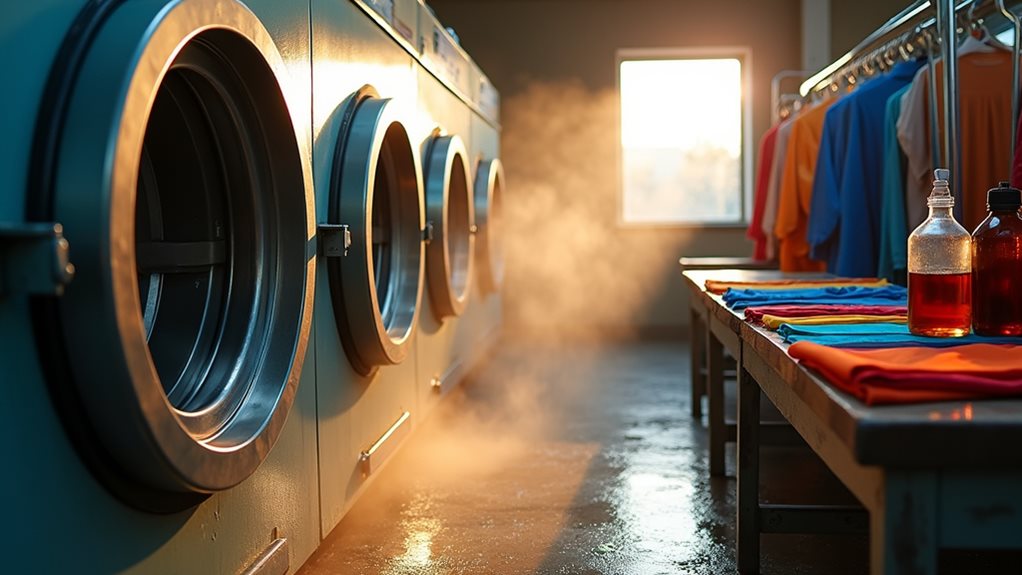Dry cleaning in India follows the same core process you’ll find worldwide, starting with careful inspection and tagging of your delicate sarees or embroidered kurtas. Your garments get loaded into specialized machines where chemical solvents like perchloroethylene gently dissolve oils and stains that water can’t handle. The clothes tumble through this chemical bath, then undergo solvent extraction and recycling—about 85-90% gets reclaimed for reuse. Finally, skilled artisans press and quality-check everything before packaging, and there’s so much more happening behind those curtains.
Inspection and Pre-Treatment of Garments
When you first walk into a bustling dry cleaning shop in Mumbai or Delhi, you’ll notice how the staff immediately begins their detective work, carefully examining each garment like a tailor-turned-investigator searching for clues.
They’re conducting a thorough inspection, checking for stains, tears, and missing buttons before the actual cleaning process begins. Each piece gets tagged for tracking – trust me, you don’t want your favorite kurta getting mixed up!
The pre-treatment phase involves applying specific spotting agents to different types of stains, whether they’re oil-based from that delicious butter chicken or protein-based from, well, life happens 😅.
This careful preparation guarantees the quality of your garments remains intact throughout the entire cleaning process, making everything more efficient. This meticulous initial stage is crucial because it targets stains that water-based washing cannot handle effectively, ensuring your delicate fabrics receive the specialized care they need.
Loading Clothes Into Specialized Machines
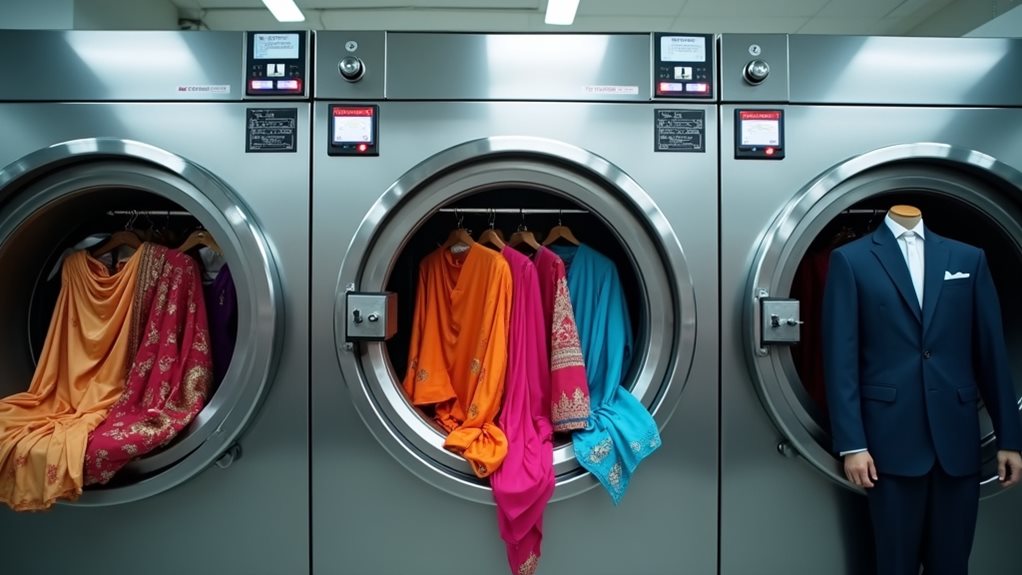
After completing their meticulous inspection, the dry cleaning technicians begin the careful choreography of loading your freshly tagged garments into these impressive, drum-like machines that honestly look like they could wash a small car.
The loading process becomes an art form, where each piece gets positioned strategically to guarantee proper care and prevent damage during the cleaning cycle. You’ll notice how specialized dry-cleaning machines accommodate different fabric weights, from delicate silk blouses to heavy wool coats, creating a balanced distribution that maximizes exposure to the cleaning solvent.
Every garment inspected for stains receives its designated spot, while identification tags serve dual purposes—tracking your belongings and making certain nothing gets lost in this carefully orchestrated dance of fabric and technology. These industrial machines utilize specialized solvents like perchloroethylene or eco-friendly alternatives that dissolve oils and grease without damaging sensitive materials.
Application of Chemical Solvents
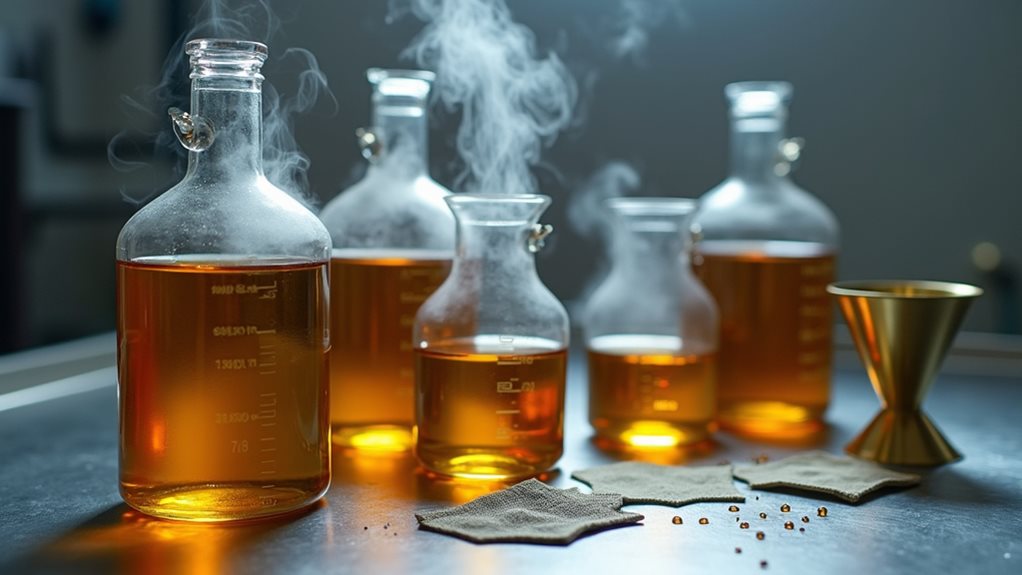
Once your garments settle into their designated spots within the machine’s spacious drum, the real magic begins as technicians introduce perchloroethylene—or “perc” as industry folks affectionately call it—into the sealed chamber, creating what fundamentally becomes a gentle chemical bath for your precious fabrics.
This dry cleaning solvent works differently than water-based washing, dissolving oils and greases that would otherwise cling stubbornly to your delicate fabrics. The specialized machine tumbles your clothes through this chemical bath, guaranteeing every fiber gets attention while maintaining ideal cleaning efficiency.
What’s brilliant about this cleaning process is how chemical solvents preserve your garment’s integrity, helping maintain original color and texture. Plus, the solvent gets filtered and reused afterward—pretty environmentally responsible, right? 😊
Many dry cleaners are now transitioning to eco-friendly options like GreenEarth silicone-based solutions and liquid carbon dioxide to address environmental and health concerns associated with traditional solvents.
Agitation and Cleaning Process
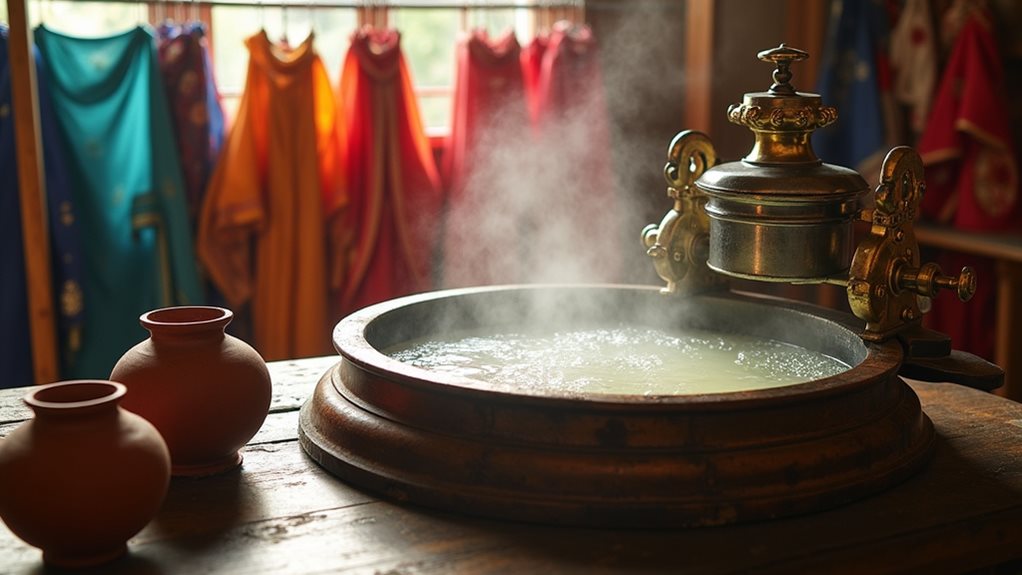
Once you’ve watched those chemical solvents work their magic on your favorite silk saree, you’ll notice the real action begins when the machine’s drum starts its rhythmic rotation, creating that gentle tumbling motion that reminds me of my grandmother’s old washing technique, except infinitely more precise and fabric-friendly.
The beauty lies in how this controlled agitation allows the solvent to penetrate deep into every fiber, loosening stubborn curry stains and everyday grime while your garments dance safely in their chemical bath, protected from the harsh scrubbing that would normally make delicate fabrics cry for mercy 😅.
It’s fascinating how this mechanical choreography, combined with the solvent’s molecular prowess, transforms dirt removal from a brutal battle into an elegant extraction process that leaves your clothes refreshed and ready for another round of Delhi’s dusty adventures.
After the cleaning cycle completes, the garments undergo solvent extraction to remove any remaining chemicals, followed by careful drying and pressing to restore their pristine appearance.
Drum Rotation Mechanics
Spinning gracefully within the confines of stainless steel chambers, the drum becomes the heart of India’s dry cleaning revolution, where delicate silk sarees and heavy woolen shawls alike find their gentle salvation.
You’ll notice how these drum rotation mechanics work like a careful dance, with your garments tumbling at precisely calibrated speeds that won’t stress delicate fabrics. The agitation process guarantees cleaning solvent penetrates every fiber, loosening stubborn dirt and oils without the harsh scrubbing you’d get at home.
Think of it as a gentle massage for your clothes – the cleaning agents distribute evenly while the drum’s controlled movement prevents damage.
After this therapeutic cycle, continued rotation helps extract excess solvent, preparing your treasured pieces for their final drying phase. This method is particularly effective at removing oil-based stains that traditional water-based washing simply cannot eliminate.
Solvent Penetration Methods
As the drum finds its rhythm, something magical happens beneath the surface – the solvent begins its intricate dance with every thread, seeping deep into fabric fibers where ordinary washing could never reach.
You’ll witness how perchloroethylene’s molecular structure allows incredible penetration, working like a determined detective that won’t give up until every hiding spot is investigated.
The agitation creates gentle pressure waves that push the cleaning solvent deeper into garments, guaranteeing even your most stubborn stains surrender without a fight.
This process brilliantly removes dirt and oils while protecting delicate fabrics from water’s harsh grasp – think of it as giving your clothes a spa treatment rather than a military boot camp experience! 😊
After the cleaning cycle completes, the garments undergo solvent extraction and drying to remove any remaining chemical residue before moving to the finishing stage.
Dirt Removal Techniques
When the drum picks up momentum and your clothes begin their tumble dance, you’re watching dirt removal in its most elegant form – imagine a gentle washing machine that uses chemistry instead of brute force to win the battle against stains.
The agitation process works like a patient friend who knows exactly how much pressure to apply, allowing the cleaning solvent to penetrate deep into fabric fibers where stubborn oils and greases hide.
This dry-cleaning process protects delicate fabrics while the tumbling motion loosens embedded dirt particles, creating a suspended mixture that’s easily filtered away.
It’s honestly fascinating how this mechanical ballet maintains cleanliness standards while treating your silk blouse better than you probably treat yourself! 😊
Modern dry cleaning machines commonly use perchloroethylene as the primary solvent to dissolve oils and dirt without causing damage to sensitive materials.
Filtration and Solvent Recovery
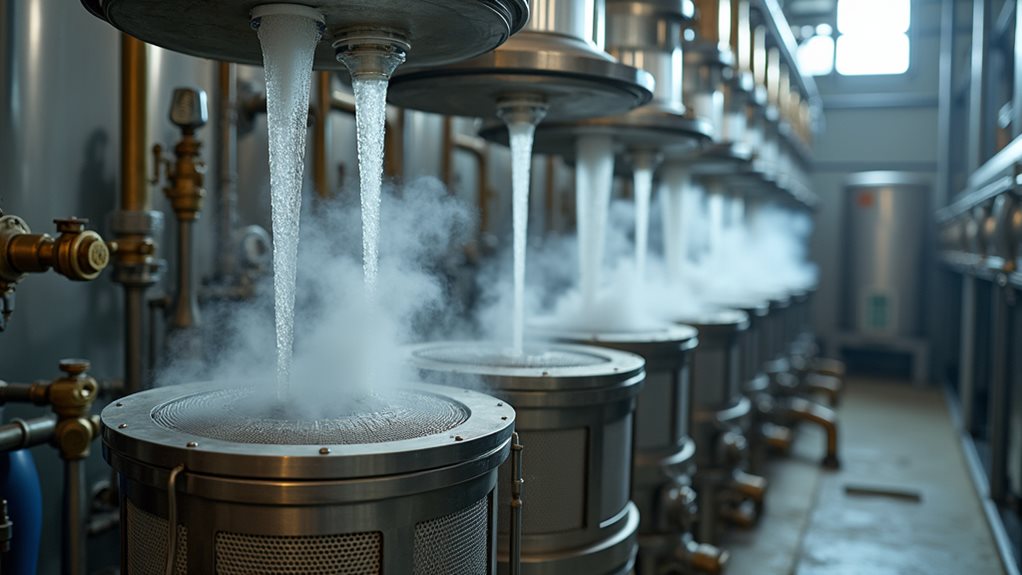
After your clothes have been thoroughly agitated and cleaned, you’ll find that the real magic happens when the dirty solvent gets filtered through specialized systems that capture all those stubborn particles and contaminants, guaranteeing your next batch of cleaning stays pristine.
The filtration process works like a sophisticated coffee filter 😊, trapping dirt while allowing clean solvent to pass through, which then moves into distillation chambers where heat separates any remaining impurities from the valuable cleaning fluid.
This recycling dance means most dry cleaners can reclaim around 85-90% of their solvent, which honestly saves them thousands of rupees while keeping harmful chemicals from polluting our beautiful Indian environment.
While many Indian dry cleaners still rely on perchloroethylene due to its excellent cleaning properties and ability to dissolve oils and greases without damaging delicate fabrics, the industry is gradually exploring more environmentally friendly alternatives.
Solvent Filtration Process
While most people think dry cleaning magic ends once their clothes emerge spotless from the machine, the real behind-the-scenes action happens during solvent filtration, a process that’s honestly more fascinating than I expected when I first learned about it.
You’ll find that during each cleaning cycle, used solvents get pushed through multiple filter stages—think coarse filters first, then fine ones—systematically removing dirt and impurities that were suspended while cleaning your favorite silk blouse.
Advanced dry cleaning machines in India now feature automated filtration systems that work tirelessly, reducing operational costs while minimizing environmental impact.
After filtration, distillation heats the solvent to separate remaining contaminants, creating recycled solvents ready for future use—pretty clever efficiency! 🧽
The most commonly used solvent in Indian dry cleaning operations is perchloroethylene (PERC), prized for its exceptional ability to dissolve oils and greases while maintaining chemical stability throughout the filtration and recovery process.
Distillation and Recycling
The distillation process takes this filtration concept several steps further, and I’ll admit I was genuinely surprised to discover just how sophisticated these recovery systems have become in Indian dry cleaning operations.
You’ll find that distillation involves heating used perchloroethylene to separate impurities, creating clean solvent that’s ready for reuse – it’s basically recycling at its finest!
The filtration process works alongside this heating method, using mechanical filters and activated carbon to guarantee maximum purity before distillation begins.
What really impressed me was learning that modern solvent recovery systems can reclaim up to 95% of the original solvent, dramatically reducing operational costs while being environmentally friendly.
While perchloroethylene remains the dominant choice, many Indian dry cleaners are exploring eco-friendly alternatives like hydrocarbon-based cleaners and liquid silicone to address growing environmental and health concerns.
It’s a win-win situation that makes dry cleaning more sustainable!
Drying and Moisture Removal
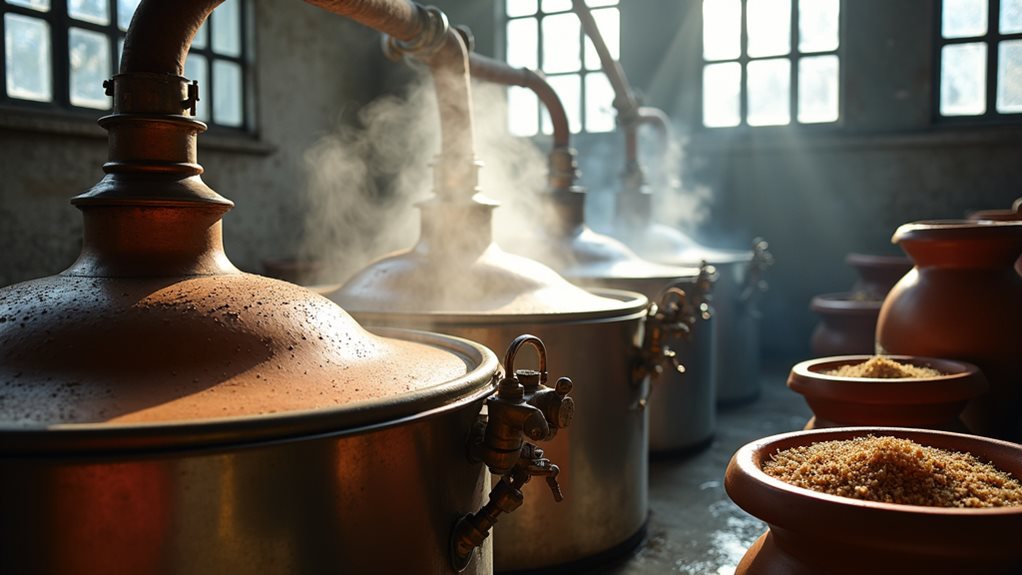
Once garments emerge from their solvent bath, they’re dripping wet and need careful attention to remove every trace of moisture—a process that’s honestly more delicate than you might think, especially when you’re dealing with those gorgeous silk saris or wool shawls that seem to have a mind of their own.
The extraction phase begins immediately, spinning garments rapidly to eliminate most solvent. Then specialized equipment takes over the drying process. Warm air circulates through chambers, guaranteeing moisture removal happens evenly across delicate fabrics without causing those heartbreaking shrinkage disasters we’ve all witnessed.
After thorough garment inspection, your precious pieces emerge completely dry, with proper mildew prevention techniques protecting them from any lingering dampness that could ruin months of careful preservation.
Professional Pressing and Finishing
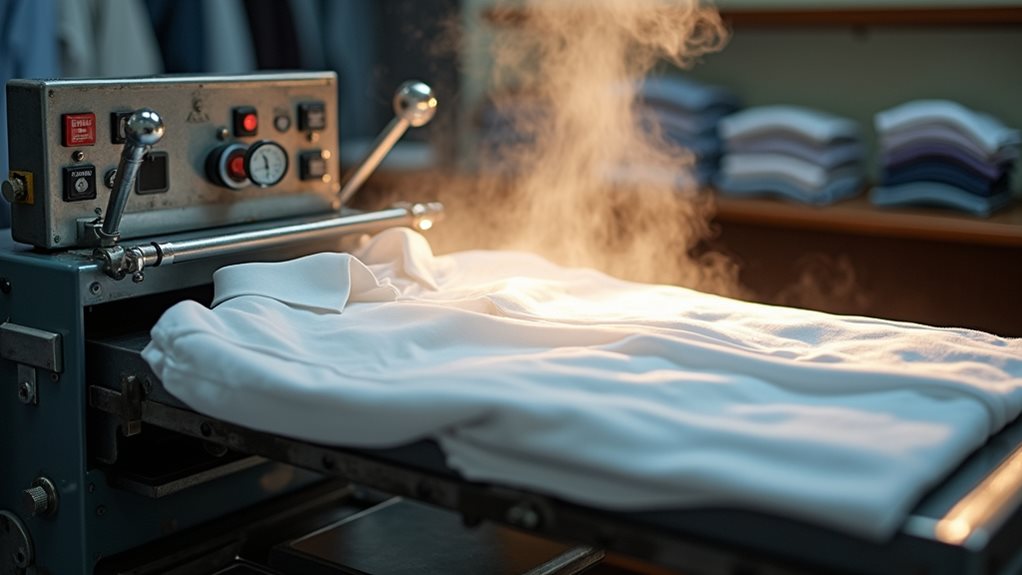
After your freshly cleaned garments have dried completely, they head straight into what I consider the most magical part of the entire process—professional pressing and finishing, where skilled artisans transform wrinkled, shapeless pieces back into the crisp, elegant clothing you remember falling in love with.
These experts understand that pressing techniques must match your garment’s specific fabric type, whether it’s delicate silk requiring gentle handling or sturdy cotton that can withstand high temperatures.
Using specialized cleaning equipment and steam, they methodically eliminate every stubborn wrinkle while preserving garment integrity.
The professional care doesn’t stop there—each piece undergoes a thorough quality check before packaging, guaranteeing you’ll receive clothing that looks absolutely perfect and maintains its longevity through proper finishing techniques.
Quality Control and Packaging

While professional pressing transforms your garments beautifully, quality control represents the final checkpoint where experienced inspectors become your personal advocates, carefully examining every inch of fabric to catch what others might miss.
Think of it as having a perfectionist friend who notices the tiny stain you’d overlook 😊.
During this meticulous inspection, trained eyes search for persistent stains that survived the initial cleaning process, applying additional spot treatments when necessary to achieve flawless results.
The pressing techniques guarantee your clothes maintain their original shape, while thorough cleanliness standards assure you’ll receive garments that look better than when you dropped them off.
Finally, careful packaging on hangers or in protective bags prevents wrinkles and keeps everything pristine until pickup.

